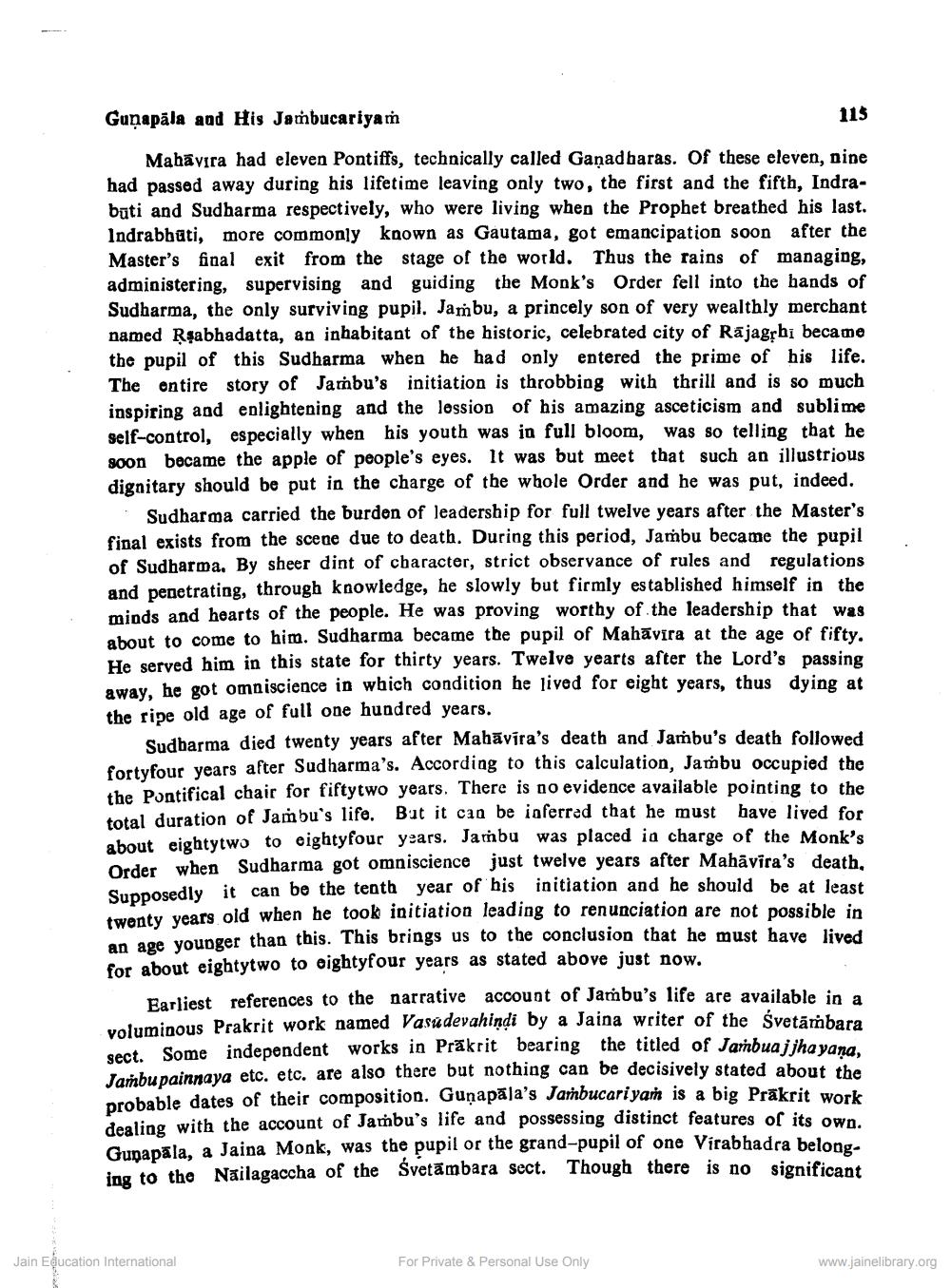________________
Gunapäla and His Jambucariyam
115
Mahāvıra had eleven Pontiffs, technically called Gaņad baras. Of these eleven, pine had passed away during his lifetime leaving only two, the first and the fifth, Indrabūti and Sudharma respectively, who were living when the Prophet breathed his last. Indrabhati, more commonly known as Gautama, got emancipation soon after the Master's final exit from the stage of the world. Thus the rains of managing, administering, supervising and guiding the Monk's Order fell into the hands of Sudharma, the only surviving pupil. Jambu, a princely son of very wealthly merchant named Rşabhadatta, an inhabitant of the historic, celebrated city of Rājagļhi became the pupil of this Sudharma when he had only entered the prime of his life. The entire story of Jambu's initiation is throbbing with thrill and is so much inspiring and enlightening and the lession of his amazing asceticism and sublime self-control, especially when his youth was in full bloom, was so telling that he soon became the apple of people's eyes. It was but meet that such an illustrious dignitary should be put in the charge of the whole Order and he was put, indeed.
Sudharma carried the burden of leadership for full twelve years after the Master's final exists from the scene due to death. During this period, Jambu became the pupil of Sudharma, By sheer dint of character, strict observance of rules and regulations and penetrating, through knowledge, he slowly but firmly established himself in the minds and hearts of the people. He was proving worthy of the leadership that was about to come to him. Sudharma became the pupil of Mahāvira at the age of fifty. He served him in this state for thirty years. Twelve yearts after the Lord's passing away, he got omniscience in which condition he lived for eight years, thus dying at the ripe old age of full one hundred years.
Sudbarma died twenty years after Mahavira's death and Jambu's death followed fortyfour years after Sudharma's. According to this calculation, Jambu occupied the the Pontifical chair for fiftytwo years. There is no evidence available pointing to the total duration of Jambu's life. But it can be inferred that he must have lived for about eightytwo to eightyfour years. Jaribu was placed in charge of the Monk's Order when Sudharma got omniscience just twelve years after Mahavira's death. Supposedly it can be the tenth year of his initiation and he should be at least twenty years old when he took initiation leading to renunciation are not possible in
w younger than this. This brings us to the conclusion that he must have lived for about eightytwo to eightyfour years as stated above just now.
Barliest references to the narrative account of Jaribu's life are available in a voluminous Prakrit work named Vasudevahindi by a Jaina writer of the Svetämhara sect. Some independent works in Prakrit bearing the titled of Jambua iihava Jambu painnaya etc. etc. are also there but nothing can be decisively stated about the probable dates of their composition. Guņapāla's Jambucariyan is a big Prakrit work dealing with the account of Jambu's life and possessing distinct features of its own Gunapala, a Jaina Monk, was the pupil or the grand-pupil of one Virabhadra belon ing to the Nailagaccha of the Svetāmbara sect. Though there is no significant
Jain Education International
For Private & Personal Use Only
www.jainelibrary.org




